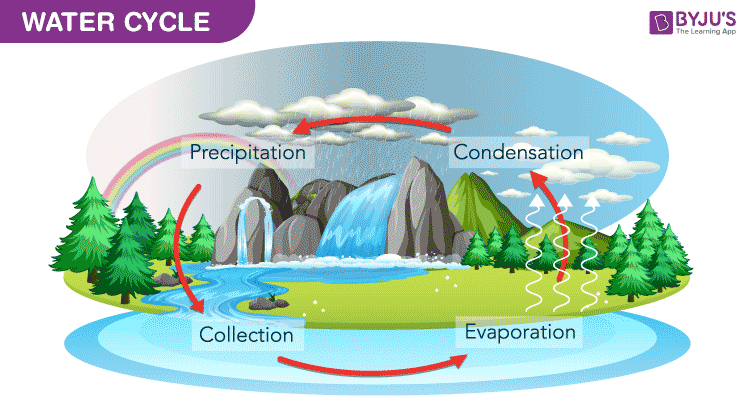everything in Earth’s system is placed into one of the four subsystems: land, water, living things, or air. The subsystems are known as “spheres.” Specifically, they are known as the geosphere (land), hydrosphere (water), biosphere (living things) and atmosphere (air). Environmentalists use this system to classify and study the organic and inorganic materials found in the Earth. In this article, we discuss these four spheres in detail.
The Geosphere
Geosphere includes all the elements that form the crust and core of the Earth. Rocks and sand particles ranging from drylands to those found at the bottom of the ocean are examples of the geosphere. Examples also involve minerals, lava, molten magma and mountains. The geosphere undergoes constant processes that modify other spheres. One of the examples is the rock cycle.

In this cycle, the melted rock from below the Earth’s crust is blown out to the surface through vents as lava. Hardened lava, together with rock materials, is weathered and eroded from earth movements. The eroded particles end up somewhere and build up. After many years of buildup, the pressure from the overlying weight causes it to bury themselves more in-depth in the crust. They are melted by the extreme heat until they are spewed out to the surface again. You may have noticed that this cycle doesn’t conclude on its own. It is affected by other factors such as the wind, temperature and water, that are a part of other spheres.
The Hydrosphere
The hydrosphere includes all the water parts of the planet. It includes water on the surface, subsurface and water vapour in the atmosphere. It undergoes infinite processes every day. The water cycle is one way to understand what is the importance of hydrosphere, its functions and how it supports other spheres.

The ocean and water bodies absorb the sun’s energy and warm up. Transpiration by trees and evaporation of surface water occurs. The water vapour in the atmosphere condenses to form rain clouds and comes down as rain. The rain falls into water bodies and the cycle continues. Other spheres are also impacted during the water cycle.
The Biosphere

Biosphere comprises all the living components of the Earth. It also includes organic matter that has not yet decayed. The sphere hugely depends on the other three spheres as follows:
- The hydrosphere replenishes plants and animals with water and moisture.
- The geosphere renders a solid surface for the plants and animals to inhabit. It also provides heat from beneath the earth.
- The atmosphere screens the sun’s UV radiation and helps us receive just enough of the sun’s heat.
A theory known as the ecosystem better explains the interaction of the biosphere with the other spheres.
The Atmosphere

The gaseous component above the surface of the Earth is known as the atmosphere. It is made of gaseous components and tiny water particles. The gases in the atmosphere are kept in place by the force of gravity. The heat from the sun is radiated to the Earth and is reflected in the atmosphere. The heat from the sun warms up the surface of the earth and causes evaporation, thereby sending moisture into the atmosphere.
The atmosphere comes in layers and the illustration below shows the different layers of the atmosphere. The troposphere is the layer closest to Earth. Humans, animals and plants live in this layer. Birds and aeroplanes also fly in this layer of the atmosphere. In the layers above the troposphere, the air becomes thinner. Beyond exosphere is space.
How Do The Earth’s Spheres Interact With Each Other?

No sphere works on its own. All the spheres in the system interact and overlap. In the section, we shall discuss the various interactions that occur among the spheres:
1. Hydrosphere and Atmosphere
The evaporation that occurs in the hydrosphere forms the medium for cloud and rain formation in the atmosphere. The atmosphere brings back this water to hydrosphere in the form of rain.
2. Hydrosphere and Geosphere
Hydrosphere provides the necessary moisture required to weather and erode rocks in the geosphere. The geosphere, in turn, allows the ice to melt and the water bodies to flow back into the oceans.
3. Atmosphere and Geosphere
The atmosphere provides the required heat and energy for the breakdown and erosion of rock in the geosphere. Geosphere, in turn, reflects the sun’s energy to the atmosphere.
4. Biosphere and Hydrosphere, Atmosphere and Geosphere
The biosphere receives sunlight and gases from the atmosphere. It collects water from the hydrosphere and a living medium from the geosphere.
All four spheres can often be found in a single location. For example, the soil may contain minerals from the geosphere, moisture within the soil from hydrosphere, insects and plants from the biosphere inhabiting the soil and pockets of air present between the soil pieces. From this, we can conclude that the complete system is what makes life as we know it.
0 comments :
Post a Comment